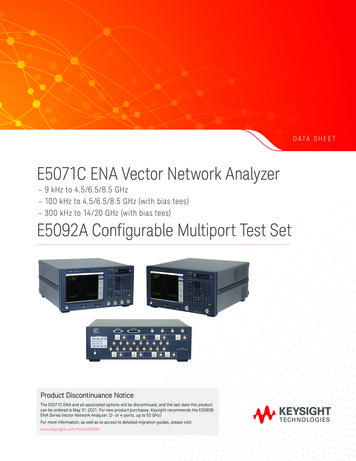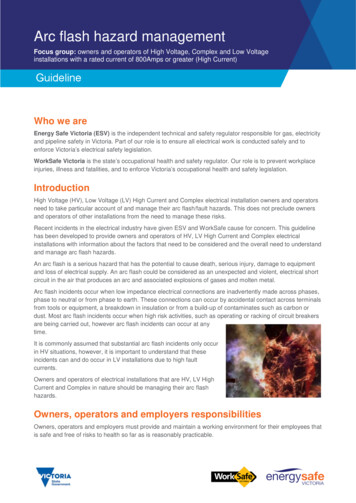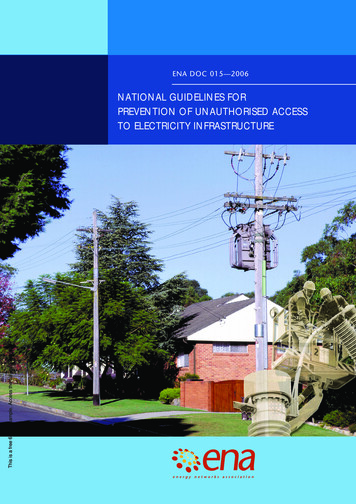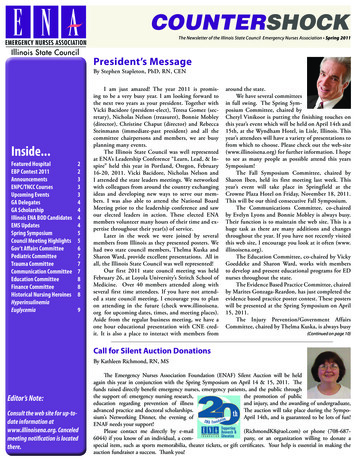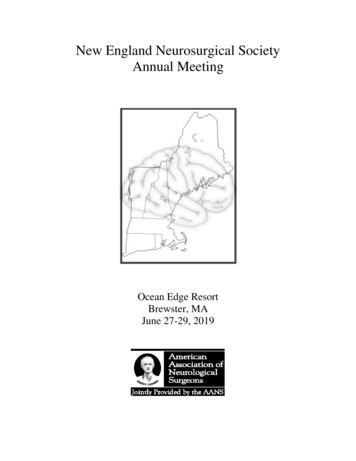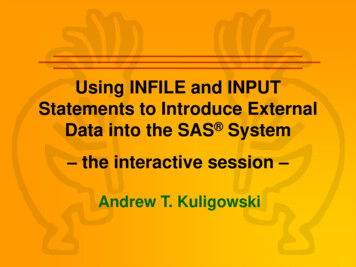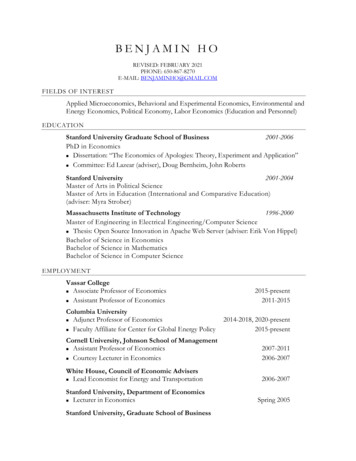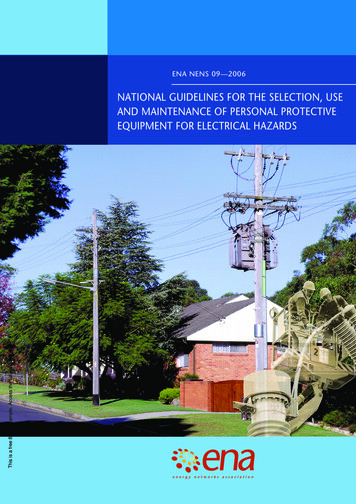
Transcription
ENA NENS 09—2006This is a free 8 page sample. Access the full version online.NATIONAL GUIDELINES FOR THE SELECTION, USEAND MAINTENANCE OF PERSONAL PROTECTIVEEQUIPMENT FOR ELECTRICAL HAZARDS
ENA NENS 09—2006NATIONAL GUIDELINES FOR THE SELECTION,USE AND MAINTENANCE OF PERSONALPROTECTIVE EQUIPMENT FOR ELECTRICALThis is a free 8 page sample. Access the full version online.HAZARDS
DISCLAIMERThis document refers to various standards, guidelines, calculations, legalrequirements, technical details and other information.Over time, changes in Australian Standards, industry standards and legislativerequirements, as well as technological advances and other factors relevant to theinformation contained in this document, may affect the accuracy of the informationcontained in this document. Accordingly, caution should be exercised in relation tothe use of the information in this document.The Energy Networks Association (ENA) accepts no responsibility for the accuracyof any information contained in this document or the consequences of any personrelying on such information.Correspondence should be addressed to the CEO, Energy Networks Association,Level 3, 40 Blackall Street, Barton, ACT 2600.First published as ESAA NENS 09—2004.This is a free 8 page sample. Access the full version online.Redesignated as ENA NENS 09—2006.COPYRIGHT Energy Networks Association 2006All rights are reserved. No part of this work may be reproduced or copied in any form or by any means, electronicor mechanical, including photocopying, without the written permission of the Association.Published by Standards Australia, GPO Box 476, Sydney, NSW 2001 for the Energy Networks Association,Level 3, 40 Blackall Street, Barton, ACT 2600.ISBN: 0 7337 7523 3
1ENA NENS 09—2006PREFACEThis Guideline is identical to the publication previously issued by the Electricity SupplyAssociation of Australia (ESAA) as ESAA NENS 09—2004 and has been redesignated andreissued by Energy Networks Association (ENA) as ENA NENS 09—2006. A number ofother ESAA documents have been reissued by the Energy Networks Association.Restructuring of the Electricity Supply Industry throughout Australia and New Zealand hasremoved traditional geographical boundaries and greatly increased the likelihood thatemployees and Service Providers move between organisations, States and Countries.The Energy Supply Association of Australia (ESAA) has produced a National ElectricityNetwork Safety Code with the objectives to: promote safety as a priority for customers, the public and industry workers; promote nationally consistent practices; promote economic efficiencies through standardization; simplify the interpretation of regulatory requirements.The following diagram outlines the framework into which these Guidelines fit. Acts andRegulationsCodesThis is a free 8 page sample. Access the full version online.Standards andGuidelinesOrganisationalPolicies, Practicesand ApprovedProceduresThese Guidelines were developed jointly by representatives of the Australian ElectricitySupply Industry, the Electrical Trades Union and the Energy Supply Association ofAustralia (ESAA).The information provided in these Guidelines will assist the Electricity Supply Industry inthe selection, use and maintenance of protective clothing and equipment used to prevent, asfar as practicable, injury from electrical hazards.The Guidelines include mandatory and advisory provisions and are formulated in such away that, depending on statutory requirements, sections that use the word ‘shall’ providemandatory provisions and sections that use the word ‘should’ provide advisory ordiscretionary provisions.The use of italics indicates the word or words are as defined in these Guidelines.These Guidelines shall be followed unless there is an alternative course of action whichachieves the same or better safety outcomes.
ENA NENS 09—20062This is a free 8 page sample. Access the full version online.These Guidelines do not substitute for, or override, any legislation, regulation or safety rulesimplemented by jurisdictional Regulators or the Electricity Supply Industry.
3ENA NENS 09—2006CONTENTS1PageOBJECTIVES . 42SCOPE. 434REFERENCED DOCUMENTS. 4DEFINITIONS. 55SELECTION, USE & MAINTENANCE OF PERSONAL PROTECTIVEEQUIPMENT . 66INSPECTION AND TESTING . 9This is a free 8 page sample. Access the full version online.ANNEX AMINIMUM CLOTHING WEIGHT REQUIREMENTS FORPROTECTION AGAINST HEAT FLUX . 10
ENA NENS 09—20064Energy Networks AssociationNational guidelines for the selection, use and maintenance of personalprotective equipment for electrical hazards1 OBJECTIVESThese Guidelines set minimum standards for the selection, use and maintenance of PersonalProtective Equipment (PPE) when used to protect employees against the electrical hazardswithin the Electricity Supply Industry.These Guidelines support the objectives of the National Electricity Network Safety Code(ESAA NENS 01) issued by the ESAA to promote nationally consistent practices within theElectricity Supply Industry.2 SCOPEThese Guidelines apply to the selection, use and maintenance of PPE for work whereelectrical hazards may be encountered during the operation, construction and maintenanceof electrical apparatus within the Electricity Supply Industry.These Guidelines are limited to insulating gloves, safety footwear, eye and face protection,head protection and protective clothing. It is recognised that there are a number of speciallymanufactured and treated fabrics used for protective clothing, however, this guideline isbased on 100% cotton drill as the minimum requirement.Additional PPE may be required for specific tasks (e.g. HV live line work, working atheights or with hazardous materials, etc). Other control measures (e.g. barriers, mats, etc)for protection against electrical hazards may also be required, dependent on the work to beperformed.These additional PPE and/or control measures are not covered in these Guidelines and shallbe identified by risk assessment and as referenced in respective Acts, Regulations, Codes,Standards and Guidelines.3 REFERENCED DOCUMENTSThis is a free 8 page sample. Access the full version online.3.1 ESSA Codes and GuidelinesESAA NENS 01-2001:National Electricity Network Safety CodeESAA NENS 02-2001:National Electricity Network Operator and Service ProviderSafety Assurance GuidelinesESAA NENS 03-2003:National Guidelines for Safe Access to Electrical and MechanicalApparatusESAA NENS 04-2003:National Guidelines for Safe Approach Distances to ElectricalApparatusESAA Handbook -HB LLM 01 Guidelines for live line barehand workESAA Handbook -HB LLM 02 Guidelines for live line stick workESAA Handbook -HB LLM 03 Guidelines for live line glove and barrier work3.2 Australian Standards and Australian/New Zealand StandardsAS 2225—1994Insulating gloves for electrical purposesAS 2919—1987Industrial clothingAS/NZS 1336:1997Recommended practices for occupational eye protectionCOPYRIGHT
5ENA NENS 09—2006AS/NZS 1337:1992Eye protectors for industrial applicationsAS/NZS 1800:1998Occupational protective helmets – Selection, care and useAS/NZS 1801:1997Occupational protective helmetsAS/NZS 1906.4:1997Retroreflective materials and devices for road traffic controlpurposes – High visibility materials for safety garmentsAS/NZS 2210.1:1994Occupational protective footwear – Guide to selection, care anduseAS/NZS 4360:1999Risk managementAS/NZS 4836:2001Safe working on low-voltage electrical installations3.3 Other referenced documentsTCA Test Series 8003 (June 2002) and 8047 (November 2002).4 DEFINITIONSThis section details a list of words and terms and their definitions as intended for use inthese Guidelines. When a word or term is shown in italics in the text of the Guidelines, ithas the following defined meaning:‘Approved’ means having appropriate organisation endorsement in writing for a specificfunction.‘Competent’ means having the skills, knowledge and attributes a person needs to completea task.‘Conductor’ means a wire, cable or form of metal designed for carrying electric current.‘De-energised’ means not connected to any source of electrical supply, but not necessarilyisolated.‘Electrical apparatus’ means any electrical equipment, including overhead lines andunderground cables, the conductors of which are live or can be made live.This is a free 8 page sample. Access the full version online.‘Electrical operating work’ means work involving the operation of switching devices,links, fuses or other connections intended for ready removal or replacement, provingelectrical conductors de-energised, earthing and/or short-circuiting, locking and/or taggingof electrical apparatus and erection of barriers and/or signs.‘Electricity Supply Industry’ means the employers, employees, contractors and any otherpersons involved in the design, construction, maintenance or operation of the electricitygeneration, transmission and distribution systems in Australia.‘Energised’ means connected to a source of electrical supply.‘Exposed conductor’ means an electrical conductor, approach to which is not prevented bya barrier of rigid material or by insulation that is adequate under a relevant AustralianStandard specification for the voltage concerned.‘Flame retardant’ means having properties that suppress or delay the combustion orpropagation of flame.‘Hierarchy of controls’ means measures taken to minimise risks to the lowest levelreasonably practicable in the descending order of: Elimination, Substitution, EngineeringControls, Administrative Controls, and PPE.‘High voltage (HV)’ means a nominal voltage exceeding 1,000V alternating current (a.c.)or exceeding 1,500V direct current (d.c.).COPYRIGHT
This is a free 8 page sample. Access the full version online.ENA NENS 09-2006 National guidelines for the selection, useand maintenance of personal protective equipment for electricalhazardsThe remainder of this documentis available for purchase online atwww.saiglobal.com/shopSAI Global also carries a wide range of publications from a wide variety of Standards Publishers:Click on the logos to search the database online.
EQUIPMENT FOR ELECTRICAL HAZARDS ENA NENS 09—2006 This is a free 8 page sample. Access the full version online. ENA NENS 09—2006 . The Energy Supply Association of Australia (ESAA) has produced a National Electricity Network Safety Code with the objectives to: promote safety as a priority for customers, the public and industry workers
